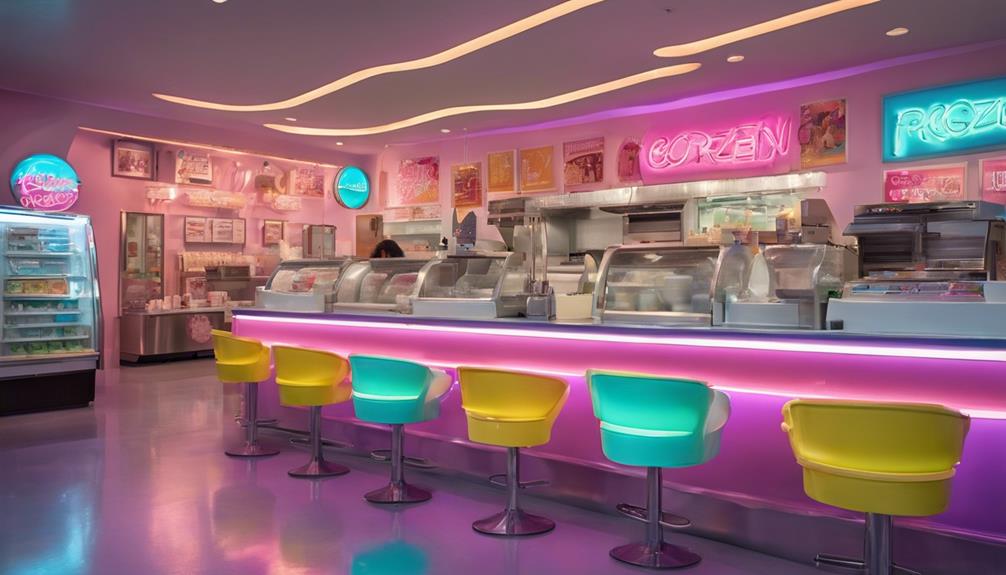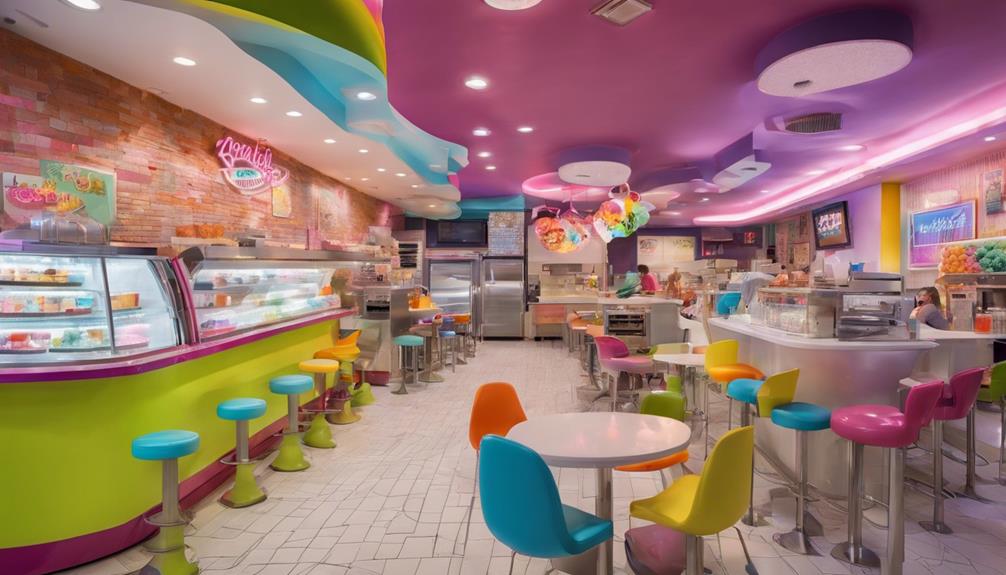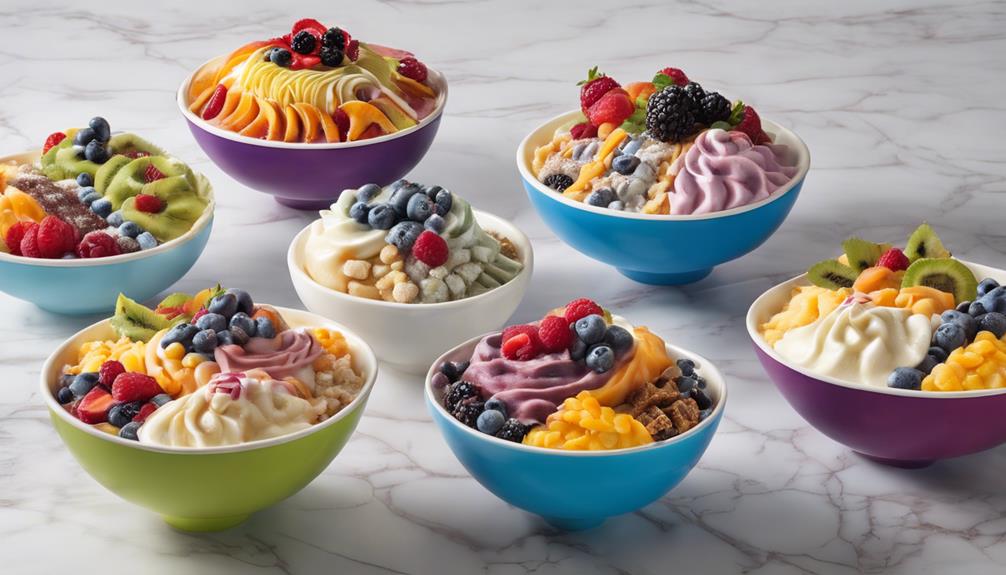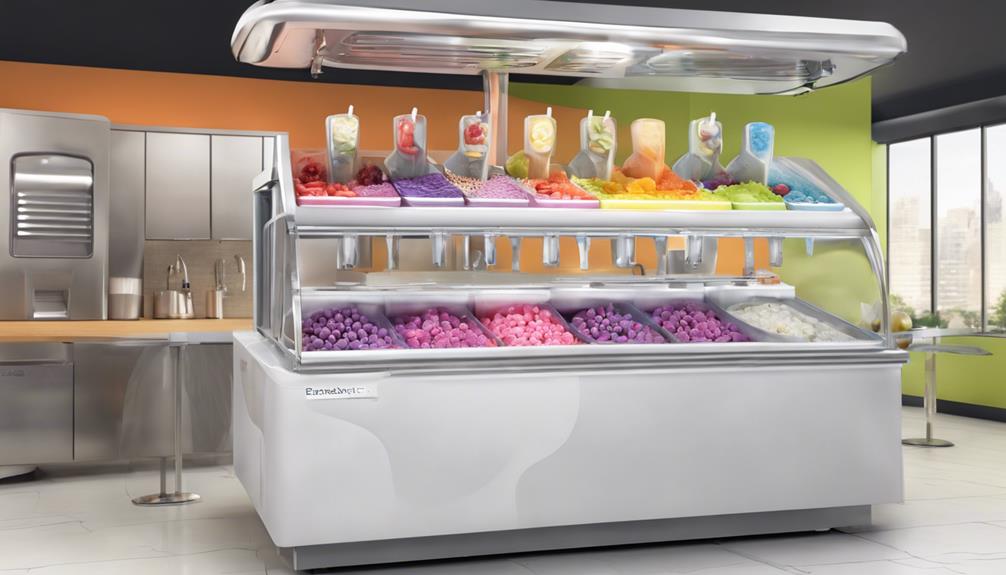Did you know that by 1984, TCBY had grown to nearly 100 stores nationwide? This rapid expansion wasn't just about offering a tasty treat; it was the beginning of a cultural shift towards healthier dessert options. As you consider the origins of frozen yogurt, you'll find that these early innovators didn't just satisfy a sweet tooth—they answered a growing demand for health-conscious alternatives. But what exactly set these pioneering stores apart, and how did they manage to create a lasting impact on the dessert industry? There's more to uncover about their journey and influence.
Key Takeaways
- H.P. Hood introduced frozen yogurt in the 1970s, setting the trend for the industry.
- Everything Yogurt, founded in 1976, was among the first to popularize frozen yogurt through rapid franchise growth.
- I Can't Believe It's Yogurt, established in 1977, gained significant popularity and was eventually acquired by Yogen Fruz in 1996.
- TCBY, founded in 1981, became the first successful frozen yogurt store with a focus on quality and customer experience.
- Freshëns targeted non-traditional locations to diversify its consumer base, contributing to the early success of frozen yogurt stores.
Origins of Frozen Yogurt

Frozen yogurt, which was first introduced in the 1970s by H.P. Hood, has frequently been seen as a healthier alternative to traditional ice cream, sparking curiosity and interest among health-conscious consumers. The origins of frozen yogurt can be traced back to its inception as a soft-serve dessert, a novel concept at the time. H.P. Hood, a dairy company, was the first to bring frozen yogurt to market, setting the stage for what would become a significant trend in the frozen dessert industry.
The initial appeal of frozen yogurt was rooted in its perceived health benefits compared to ice cream. This product offered a lower fat content and fewer calories, making it an attractive option for those looking to indulge without guilt. Additionally, the tangy flavor of frozen yogurt provided a invigorating alternative to the rich, creamy taste of ice cream, further distinguishing it in the market.
Early Innovators
In the late 1970s, pioneering establishments like Everything Yogurt and I Can't Believe It's Yogurt played a crucial role in transforming frozen yogurt from a novel concept to a mainstream dessert option, paving the way for the industry's rapid expansion. These early innovators recognized the potential of frozen yogurt as a healthier alternative to traditional ice cream and seized the opportunity to introduce it to the general public.
Everything Yogurt, founded in New York in 1976, was the first of its kind. Its rapid growth was evident by 1991, with 227 franchises and an additional 44 under construction. This expansion demonstrated the widespread appeal of frozen yogurt and established a solid foundation for the brand. Later, Everything Yogurt merged with Bananas Smoothies and Frozen Yogurt, ensuring its continued presence across the country.
Similarly, I Can't Believe It's Yogurt began its journey in Dallas, Texas, in 1977. This franchise quickly gained popularity, further cementing frozen yogurt's place in the dessert market. The brand's acquisition by Yogen Fruz in 1996 significantly increased Yogen Fruz's outlets, highlighting the impact of early innovators on the industry's growth. These pioneers set the stage for frozen yogurt's enduring popularity.
First Successful Stores

TCBY's pioneering efforts in 1981 marked a significant milestone in the frozen yogurt industry, establishing the first truly successful store and setting a new standard for future franchises. By focusing on quality and customer experience, TCBY managed to create a brand identity that resonated with consumers. This wasn't just about serving frozen yogurt; it was about crafting a unique dining experience that combined a health-conscious product with a welcoming atmosphere.
Meanwhile, Everything Yogurt, founded in 1976, had already been making strides as a popular franchise. However, TCBY's model proved more scalable and sustainable, leading to its widespread acclaim. Similarly, I Can't Believe It's Yogurt, which entered the market in 1977, saw rapid expansion but didn't quite capture the same level of enduring success. TCBY's strategic location choices and marketing efforts were key differentiators.
Freshëns, established in 1985, took a different approach by targeting non-traditional locations such as airports and college campuses, diversifying its consumer base. Yogen Fruz, starting in 1986, exemplified international growth with over 1,300 locations by 2012. Each of these brands contributed to the evolving landscape, but TCBY's early success set the benchmark for what a thriving frozen yogurt franchise could achieve.
Popularity Surge
The meteoric rise in the popularity of frozen yogurt can be traced back to the early 1980s, when pioneering stores like TCBY began to captivate health-conscious consumers and redefine the dessert landscape. TCBY, opening its doors in 1981, spearheaded this revolution by offering a low-fat, probiotic-rich alternative to traditional ice cream. This innovative approach resonated with a growing demographic concerned about diet and wellness.
By 1986, TCBY's success was undeniable, turning the frozen yogurt industry into a $25 million market. The momentum continued into the 1990s, with frozen yogurt capturing 10% of the frozen dessert market. The industry's appeal wasn't just about health; it also embraced customization and variety, drawing in a diverse customer base.
Key factors driving the popularity surge included:
- Health-conscious trends: Consumers sought lower-fat, probiotic-rich options.
- Market expansion: Chains like TCBY proliferated, making frozen yogurt widely accessible.
- Customization: Toppings and flavor choices offered personalized experiences.
- Trendy appeal: Shops became popular social spots.
With the introduction of Pinkberry in 2005, the frozen yogurt market experienced a 21st-century renaissance, leading to a projected industry revenue of $2.1 billion by 2019. Clearly, frozen yogurt's ascent was more than a fad—it was a cultural shift.
Impact on Dessert Industry

You might notice how the first frozen yogurt stores didn't just cater to health-conscious consumers; they also reshaped the dessert landscape by influencing your preferences. This shift spurred intense competition, prompting both established brands and new entrants to innovate rapidly. As a result, the market saw an explosion of diverse options, challenging traditional dessert norms and pushing the industry towards more personalized and health-focused offerings.
Changing Consumer Preferences
As consumer preferences shifted towards healthier eating habits, the dessert industry saw a significant transformation with the emergence of frozen yogurt stores that offered lower-fat, lower-calorie alternatives to traditional ice cream. You likely noticed how frozen yogurt quickly became a popular healthier option, catering to a growing demand for nutritious yet delicious treats.
This shift in consumer behavior led to several key changes in the dessert landscape:
- Health Consciousness: People started to prioritize their health, seeking desserts that aligned with their dietary goals, making frozen yogurt an attractive alternative.
- Customization: Frozen yogurt stores capitalized on the trend of personalization by offering a variety of toppings and flavors, allowing you to tailor your dessert to your taste and nutritional preferences.
- Market Adaptation: Traditional ice cream shops had to adapt by either incorporating frozen yogurt into their offerings or emphasizing their unique qualities to retain customers.
- Innovation: The success of frozen yogurt paved the way for further innovation in the dessert industry, encouraging the development of other health-focused treats.
Rise of Competitors
With competitors like Pinkberry, Red Mango, and Yogurtland entering the market, the dessert industry experienced a significant shift towards health-focused, customizable dessert options. These frozen yogurt chains capitalized on consumer demand for healthier alternatives by offering products made with real yogurt, which not only provided a tangy flavor but also boasted probiotic benefits. This shift was a game-changer, appealing to health-conscious consumers who were previously underserved by traditional dessert offerings.
The introduction of self-serve machines by brands like 16 Handles further revolutionized the industry. This innovation allowed you to control portion sizes and customize your toppings, making the dessert experience both interactive and personalized. As a result, frozen yogurt chains expanded rapidly, both domestically and internationally, changing the landscape of the dessert industry.
The global expansion of these chains didn't just offer more locations to enjoy frozen yogurt; it also set new standards for the industry. By popularizing the use of real yogurt, these competitors made health-focused desserts mainstream. You could now indulge without the guilt, enjoying a dessert that was both delicious and aligned with healthier eating habits. This shift had a lasting impact, driving the dessert industry towards more nutritious and customizable options.
Legacy and Influence
When you consider the pioneers of frozen yogurt like TCBY, their impact on market expansion is undeniable. These early stores didn't just introduce a new dessert; they reshaped consumer preferences and paved the way for modern establishments like Pinkberry and Menchie's. The legacy of these trailblazers is evident in today's thriving frozen yogurt culture, characterized by diverse flavors and customizable options.
Pioneers of Frozen Yogurt
TCBY's pioneering venture in 1981 set the stage for the frozen yogurt industry's evolution, establishing a legacy that subsequent brands like Pinkberry, 16 Handles, and Menchie's would build upon to transform frozen yogurt into a beloved, customizable dessert phenomenon. By opening the first frozen yogurt stores, TCBY didn't just introduce a new product; they created a new market. Their approach made frozen yogurt a popular alternative to traditional ice cream, capturing the imagination of health-conscious consumers.
Pinkberry's debut in 2005 amplified this legacy by focusing on customization and fresh ingredients, offering a unique experience that was both innovative and engaging. Their stores became synonymous with trendy, health-oriented dessert options.
16 Handles took it a step further with the introduction of self-service machines, revolutionizing the way customers interacted with frozen yogurt. This innovation added a layer of convenience and choice, making frozen yogurt even more appealing.
Menchie's, founded in 2007, quickly expanded to become the largest frozen yogurt franchise globally. They continued to build on the legacy of their predecessors by emphasizing:
- Family-friendly environments
- Diverse flavor options
- Community involvement
- High-quality ingredients
These pioneering stores each played a significant role in making frozen yogurt a staple in the dessert landscape.
Market Expansion Impact
The frozen yogurt market's expansion in the 1980s and 1990s not only captured a significant share of the frozen dessert industry but also laid a foundation for the innovative, consumer-driven experiences that define the sector today. With brands like TCBY and Yogen Fruz leading the charge, frozen yogurt quickly became a staple in the dessert market. TCBY, opening its first store in 1981, expanded to 3,000 locations in 70 countries by 2000, showcasing the immense potential and popularity of frozen yogurt.
This market expansion wasn't just about increasing store numbers; it fundamentally altered consumer expectations. The introduction of self-serve and customizable options by newer brands like Pinkberry and 16 Handles revolutionized how customers engaged with frozen yogurt. These innovations not only attracted a loyal customer base but also influenced broader trends within the dessert industry, emphasizing personalization and interactive dining experiences.
The legacy of pioneering chains from the late 20th century, such as Everything Yogurt and I Can't Believe It's Yogurt, paved the way for today's franchises. The impact of this market expansion remains significant, with the frozen yogurt sector projected to achieve a market revenue of $2.1 billion by 2019.
Modern Store Inspirations
Revolutionizing the frozen yogurt industry, modern stores like Pinkberry and 16 Handles have profoundly influenced the sector by emphasizing sleek designs and customizable, self-serve options. Pinkberry, introduced in 2005, set a new standard with its chic interiors and focus on flavor customization. This approach not only drew in customers but also reshaped consumer expectations about frozen yogurt experiences.
16 Handles further advanced the industry by introducing a self-service model with numerous flavor choices. This allowed customers to personalize their frozen yogurt, making each visit unique and engaging.
These modern store inspirations have had a lasting impact on the frozen yogurt scene:
- Pinkberry's sleek design: Set a trend for aesthetically pleasing store interiors.
- 16 Handles' self-serve model: Pioneered a new level of customer engagement and customization.
- Menchie's expansion: Showcased the scalability and global appeal of the modern frozen yogurt store.
- Red Mango's focus on health: Inspired a shift towards using real yogurt and natural ingredients.
These innovations have not only shaped customer expectations but also provided a blueprint for new entrants in the industry. By prioritizing design, customization, and health, modern frozen yogurt stores continue to attract and retain a loyal customer base.
Frequently Asked Questions
What Was the First Frozen Yogurt Company?
You might think Humphrey Yogart played a key role in the Froyo Evolution, but TCBY was actually the first frozen yogurt company, revolutionizing the industry in 1981 and setting the stage for future innovations and market growth.
Who Was the First Person to Make Frozen Yogurt?
You might think frozen yogurt's tangy flavor is a modern trend, but H.P. Hood first made it in the 1970s. Hood's innovation offered health benefits, making it a popular alternative to traditional ice cream.
What Frozen Yogurt Chain Was Founded in California?
You're looking at a rich piece of California history when examining which frozen yogurt chain started there. Pinkberry, Menchie's, Red Mango, Tutti Frutti, and Yogurtland all began in California, shaping modern yogurt trends.
What Is the Biggest Frozen Yogurt Chain?
You're asking about the biggest frozen yogurt chain, and that's Menchie's. Their expansion strategies and global presence have made them the largest froyo franchise in the world since their start in Valley Village, CA in 2007.
Conclusion
You've seen how the first frozen yogurt stores, like TCBY and Freshëns, didn't just serve dessert—they changed the game. By emphasizing health and customization, they didn't just ride a trend; they created a cultural shift. Imagine the dessert landscape today without their influence—it's almost unthinkable. Their legacy isn't just in the yogurt they served, but in the way they reshaped our cravings and choices, making healthier indulgence a delightful reality.







